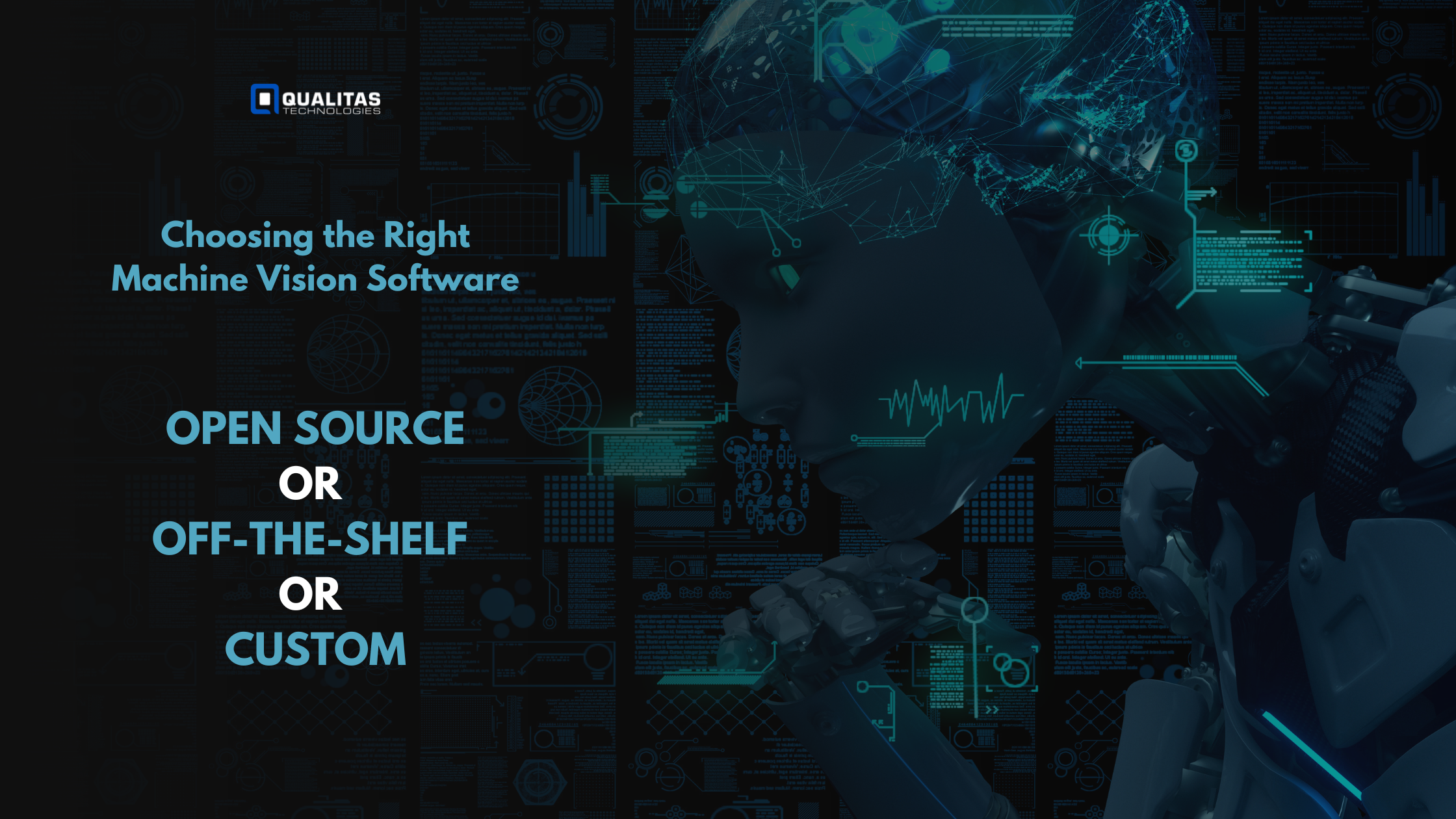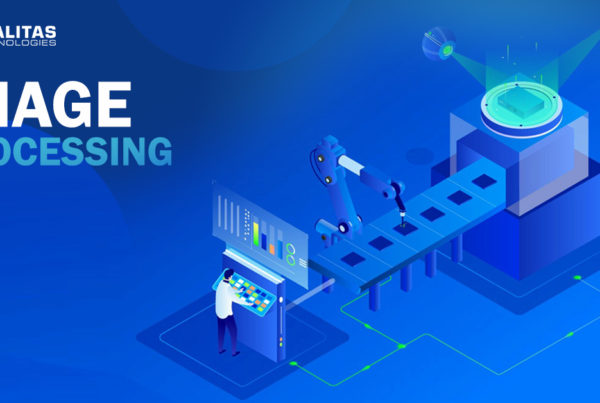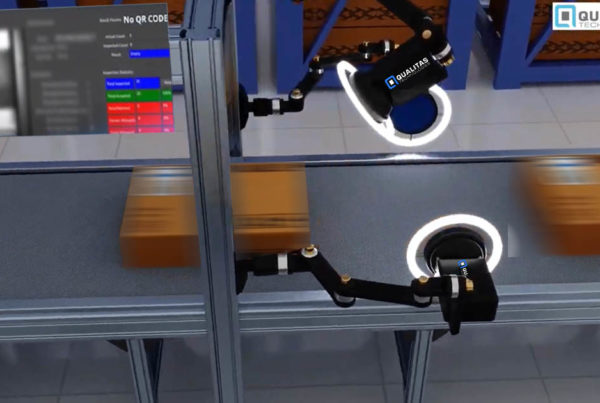
Table Of Contents
Introduction
1. Open Source
Merits
Demerits
2. Off-The-Shelf
Merits
Demerits
3. Custom built
Merits
Demerits
An AI-powered industrial machine vision inspection system leverages AI and Deep Learning to make machines ‘see’ objects and extract information from the images, almost like a human does. But going by the hype around technologies like Artificial Intelligence, Deep Learning, Machine Learning and the likes, one may be led to think that any business can point an AI-based solution at a problem, and lo and behold, the images are processed and classified as per requirement. In reality, designing and deploying a functional machine vision system involves complex steps, considerable expertise and crucial decision making ‒ decision-making because of the growing range of open source and proprietary solutions that have emerged to achieve the goal. Hype aside, DL-based AI solutions are quite a novelty in the industry, which means that the technology is still evolving. Historically, off-the-shelf software has almost always been preceded by a long period of custom software development and AI-based MV solutions are in the midst of that evolution. These considerations should be factored in when selecting an MV solution for any business. Broadly, there are three options to choose from – a free open-source software, a commercial off-the-shelf software and or a customized software solution built for a set of use-cases. Let us delve deeper to understand the subtleties involved in each one of these.
Open source
Over the last decade, the sudden spurt in the open source software industry, particularly in AI-related software, is clearly evident. With so much available, at hardly any cost, it does not make sense to build from scratch.
Merits
- The open source platforms offer models, plugins, libraries, etc., that can serve as building blocks in the development process and reduce the development time
- For any business, the cost is an advantage that cannot be ignored, and as evident from the definition itself, open source software is free to use. Since there are no recurring software license costs involved, this type of approach is practicable for simple, straightforward tasks running on constrained budgets.
- Most open source software are open for collaboration and let the developers and the end-users exchange ideas on key performance issues that might arise.
Demerits
- Understandably, open source software is not accompanied by the hardware required for the machine vision system and its biggest test is when deployed in industrial settings. The software has to be compatible with the image acquisition system and processing hardware. Any incompatibility with other systems such as PLCs, material handling, legacy factory software, etc., could result in a malfunction in the hardware. This can become a challenge to resolve without support, leading to downtime and wastage of resources. Mating each sub system with each other is critical for optimal performance. So this approach can be attempted only if the business has the ability to assemble and integrate the complete solution with its own resources.
- Open source software may or may not be flexible enough to allow in-house developers to write the code in the programming language they are familiar with, and this can be an impediment when there is a need to customize or upgrade the code to suit the requirement of the business.
- Security of data can also be of concern when using open source software as the code may not be secure enough to counter the current threats in cyberspace.
- Availability of support for such software is not guaranteed, leaving the in-house developers to shoulder the responsibility for success of the project in case of any incompatibility issues, coding errors or need for improvements.
- Future scalability and upgradation plan of the company also need to be taken into consideration while evaluating open source machine vision software since one may have to wait for further upgrades or enhancements in the software, even if only a single algorithm requires modification for better accuracy or speed.
- To ensure a robust and reliable MV solution, it is important that the algorithms have been tested extensively in a simulated environment and by certified machine vision experts. This may not be possible in the case of open source solutions, increasing the risk of failure on deployment in a real setup.
- An important consideration while choosing a software is its documentation, FAQs, and tutorials for training and tweaks, but not all open source machine vision software offer these.
Ultimately, there is still some gap between a freely downloadable machine vision software, and one that can be reliably and safely deployed in an industrial setting: The last mile still needs knowledgeable development and integration skill, which only a few industrial customers possess.
Off-the-shelf
While open-source machine vision software can serve as building blocks, off-the-shelf solutions provide a ready-for-deployment tool, tailored for a specific use case.
Merits
- Since these solutions are ready to use after initial configuration, the deployment time is faster.
- They offer a range of options and pricing models to choose from. The deployment mode could be either onsite or in the cloud.
- Such software is developed by experienced and qualified teams with the purpose of providing value at a price. Therefore, it is likely to be robust, easy to deploy, secure, and flexible.
- Software providers also offer feature enhancements and time-bound upgrades to keep pace with the changing technology.
- While most off-the-shelf solutions are designed to be plug and play, the vendor may assist with installation, training, documentation, and even structured after-sales support for a definite time.
Demerits
- An off-the-shelf software may offer limited flexibility for customization in terms of integration with third-party products, compatible hardware and data integration.
- The SLAs mentioned in fine print assume greater significance in off-the-shelf products since they are generalized and may not be as per the buyer’s needs. Generally, these tools may incur alow upfront investment, but the subscription fee, maintenance, upgrades, etc., can result in a high lifecycle cost.
- A factor that might not be apparent but quite common in off-the-shelf solutions, is the vendor lock-in, where the buyer gets locked in with the solution and the vendor, for a definite period. In case of dissatisfaction with the solution, the lock-in period prevents the buyer from terminating the contract, thus losing out on the competitive advantage that was gained by choosing an MV solution, within a short period. Apart from this, there is also the loss that occurs from the buying organization having to unlearn a lot from the previous deployment.
- Many off-the-shelf software providers discontinue support for previous versions on the release of newer ones and if the companies go out of business, then the customers are left in the lurch.
- Off-the-shelf solutions may have rich feature sets, but may still not support specific use cases that are essential to the business. Moreover, some of these additional features and capabilities for which the customer ends up paying, may be of little or no use.
Industrial visual inspection has many criteria and dependencies ‒ the type of product being inspected, nature and extent of defect, environmental factors, selection of the DL model, factoring the drifts in data and environment, and so on. Can one single off-the-shelf product capture all of these, is the question to ask. While vendors may make claims of low or no code, doing away with the requirement of ‘not good’ data samples, requiring very few training data samples and so on — the idea of a magical, one-time, ready-made DL model serving the purpose in entirety seems far fetched, at least in the current state of technology.
Custom built
This leads us to the final option within these solutions, and that is a customized one. A business setup where there is a unique or a niche product, has a host of custom integration involved, has security implications, or when greater control over the software is desired — the best option is to opt for a custom built machine vision solution.
Merits
- A custom machine vision solution developed specifically for a business guarantees that the solution fits the requirements. It caters for hardware compatibility considerations, camera, frame-grabbers, PLC, etc., and in case the in-house experts wish to make changes, allows choosingthe programming environments that they are adept at.
- A custom built solution tends to be more robust and secureas these features can be built into the code.
- Custom machine vision solutions, if so designed, can have the flexibility to scale,and expand in scope to accommodate the developments in technology down the road. Any changes in the software are easy to integrate, with minimal interruption in the operations.
- Vendors of custom built machine vision solutions usually provide installation, training, after sales support, maintenance and upgrades over the lifecycle of the product. All of these result in economies not available otherwise.
- As regards the overall timelines are concerned, custom built solutions may take longer to develop when compared with other options. But in the long run, this lost time can be made up by considerably greater throughput as a result of superior performance.
Demerits
- It goes without saying that the upfront cost of a custom built solution would be more than the other two. However, these expenses pay off over time and can give a better ROI when compared to costs incurred in open source or off-the-shelf solutions like renewal of subscriptions, addition of security features, customization, or even during integration with existing systems.
- A business has to put in considerable effort in system development, be it an external or in-house development team. Design, developing, testing and commissioning a custom machine vision solution may take months before being declared production ready.
It emerges from the foregoing that a customized machine vision may be the most preferred option due to the inherent advantages. The right solution for any business, however, is the one that increases productivity while giving a good ROI. A custom software does not necessarily mean that every piece of the solution code is written from scratch and keeping that as a basis, the optimum approach today might be a judicious combination of all the 3 approaches – (1) Open source, open access resources whenever warranted, so that ‘reinventing the wheel’ is either eliminated or minimized, (2) Re-usable software components that, with time, become practically off-the-shelf – meaning that these pieces can be reused without change, (3) Customization for the remaining pieces of the total solution – and then overall integration for the intended application.
By providing cost optimal yet highly specialized customized AI-powered visual inspection solution in EagleEye®, Qualitas Technologies sets out to achieve just that. As part of this solution, Qualitas offers a bespoke design and development for industrial grade image acquisition along with an image processing platform that includes specialized pre-trained DL models for accurate visual inspection, end-to-end ML ops support for training and inferencing, and deployment support for cloud and edge.





